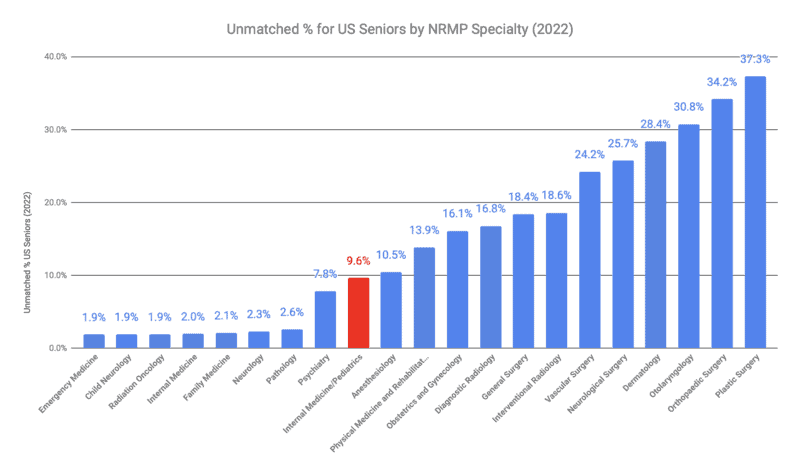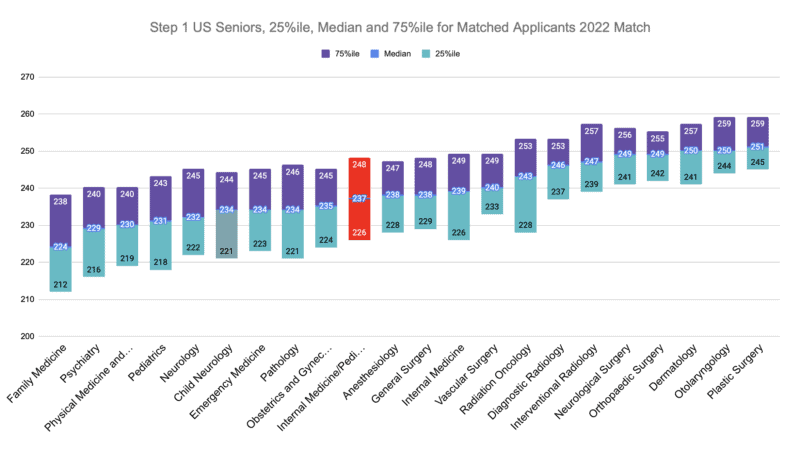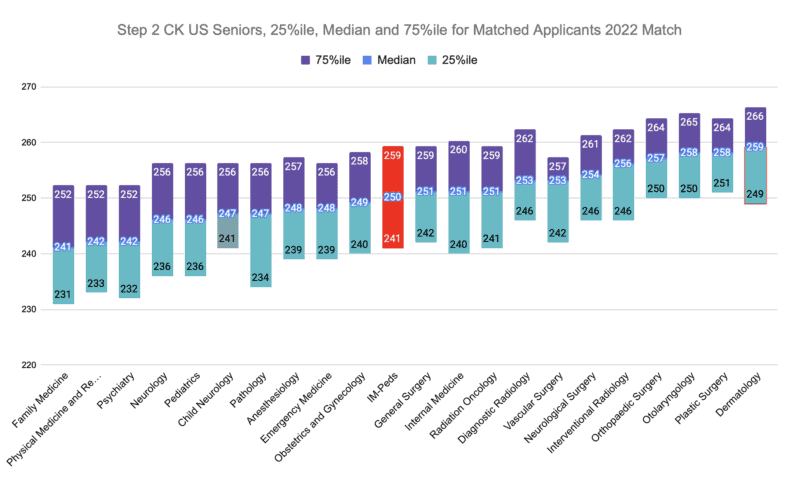

Curious to know what your MCAT score would translate to on the USMLEs? If you had to apply TODAY to match into internal medicine/pediatrics, would your MCAT score make the cut?
As an undergrad, maybe you did well on standardized testing and often excelled when compared to your peers. As a med student, maybe you’ve experienced imposter syndrome and often feel you are underperforming. In a sense, that is true. However, your “underperformance” is simply because you are surrounded by people who on average did much better on standardized tests during undergrad.
We can use the percentile score for matriculants to US med schools to help make a comparison with USMLE matching scores for internal medicine/pediatrics. For example, the average MCAT score for all test-takers between 2019-2021 was 501.6 (SD 10.8). However, the average MCAT for matriculants to US med schools was 511.9 (SD 6.6).
In other words, the 50%ile MCAT score for matriculants was at roughly 84%ile of all MCAT test-takers.
Is Internal Medicine/Pediatrics Competitive?
First, let’s look at the general competitiveness of internal medicine/pediatrics. One way to assess the competitiveness of a specialty is to look at the match rate – the % of people who apply who end up matching into their preferred specialty.
Among US Seniors, the unmatched percentage was 9.6%, making it moderately competitive among US residencies. The match rate for internal medicine/pediatrics is considerably better than the most competitive specialties like plastic surgery, orthopedic surgery, or otolaryngology. However, internal medicine/pediatrics is considerably more competitive than pediatrics, emergency medicine, child neurology, or even radiation oncology in the 2022 match.
USMLE Scores for Internal Medicine/Pediatrics
Now let’s look at Step 1 scores for matched US seniors in internal medicine/pediatrics. We will use this to find the correlating MCAT score in the next step. You can also see how internal medicine/pediatrics compares to other specialties below.
Internal Medicine/Pediatrics Step 1 Scores (Matched Applicants in 2022 Match):
- 25%ile: 226
- Median: 237
- 75%ile: 248
Similarly, Step 2 CK scores for internal medicine/pediatrics for matched US seniors reflect its moderate competitiveness.
Internal Medicine/Pediatrics Step 2 CK Scores (Matched Applicants in 2022 Match):
- 25%ile: 241
- Median: 250
- 75%ile: 259
What MCAT Score to Match Into Internal Medicine/Pediatrics?
The MCAT score equivalent to the same %ile of students who matched into internal medicine/pediatrics for Step 1 would be ~514, which would rank in the 62%ile of MCAT matriculants.
For Step 2 CK, the equivalent score would be ~ 513, which would rank in the 58%ile of MCAT matriculants.
Will This Predict My USMLE Scores and Matching Chances?!
Certainly not. Instead, this is a simplified approach to consider the USMLE scores equivalent to your MCAT percentile among those admitted to medical school and how that compares to those who successfully matched into internal medicine/pediatrics.
While Step scores remain a crucial factor, the competitiveness of a specialty, interpersonal skills, and interview performance can all influence your matching prospects. Your MCAT score indicates your initial point, but your USMLE score reveals your ultimate achievement.
MCAT to USMLE Converter: Best Uses?
So what is the best use of knowing? We might use it to set “stretch” goals for ourselves. Let’s say our equivalent Step 2 CK performance might be a 250 – we might know that 260 would be a good goal, and 230 might be selling ourselves short.
Or maybe we killed ourselves to do well on the MCAT, but we still didn’t do as well as we hoped. In this case, you should start NOW to figure out where you are lacking in your learning ability and how you can become a better learner and test taker to match into your dream residency. Sign up for a free consultation TODAY to discuss how Yousmle can help you score higher, study less, and never forget what you’ve learned.
Concluding Thoughts
Keep in mind that your percentile ranking on the MCAT is unlikely to directly correlate with your percentile ranking on the USMLEs. The reason for this discrepancy is that not all individuals who take the MCAT ultimately pursue a medical career. Instead, your MCAT score is assessed in relation to the scores of individuals who achieved higher scores on the MCAT.
To estimate what kind of performance you might expect on the USMLE if your performance were similar to when you were a pre-med, you can use this MCAT to USMLE calculator.
Also, while MCAT scores correlate with USMLE scores, they are not deterministic. Many people “over-perform” or “underperform” their MCAT. A lot will depend on how you prepare in the months years leading up to your USMLEs.
References
- AAMC. MCAT Scores and GPAs for Applicants and Matriculants to U.S. MD-Granting Medical Schools, 2018-2019 through 2021-2022.
- Percentiles for Step 1, Step 2 CK, and Step 3.
- AAMC. Using MCAT® Data in 2023 Medical Student Selection.
Note on calculations: These are based on normalized distributions based on the means and standard deviations for the populations of interest (all MCAT test-takers, all MD school applicants, and all MD school matriculants; as well as Step 1, Step 2 CK, and Step 3 test-takers). Percentiles for each MCAT/USMLE score were calculated. Then, MCAT scores for matriculants were graphed, and a linear regression was performed to find a best-fit line whose equation was used in the calculator for USMLE score equivalents.










